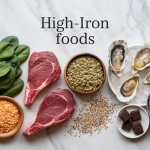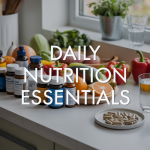Vitamin D plays a crucial role in your overall health, yet millions of people don’t get enough of this essential nutrient. This guide is for anyone who wants to understand how vitamin D affects their body and learn practical ways to maintain healthy levels.
You’ll discover the best natural sources of vitamin D and how to incorporate them into your daily routine. We’ll also cover how to spot the warning signs of deficiency, which affects nearly 40% of adults. Finally, you’ll learn effective supplementation strategies and simple lifestyle changes that help your body optimize its use of this vital vitamin.
Vitamin D and Its Essential Functions
What Vitamin D Is and Why Your Body Needs It
Vitamin D stands out as one of the most unique nutrients your body requires. Unlike other vitamins that come primarily from food, your body produces vitamin D when your skin gets exposed to sunlight. This fat-soluble vitamin acts more like a hormone than a traditional vitamin, influencing nearly every cell in your body.
Your body creates vitamin D through a fascinating process. When UVB rays from sunlight hit your skin, they convert 7-dehydrocholesterol into vitamin D3. This then travels to your liver and kidneys, where it is transformed into the active form, called calcitriol. This active vitamin D circulates through your bloodstream, binding to receptors found in tissues throughout your body.
The widespread presence of vitamin D receptors reveals just how important this nutrient is for your overall health. These receptors exist in your bones, muscles, immune cells, brain, heart, and even your reproductive organs. When vitamin D binds to these receptors, it influences gene expression and regulates various cellular processes that keep your body functioning optimally.
How Vitamin D Supports Bone Health and Calcium Absorption
Your bones depend heavily on vitamin D to stay strong and healthy. Without adequate vitamin D, your body can only absorb about 10-15% of dietary calcium. With sufficient vitamin D levels, calcium absorption jumps to 30-40%, making this vitamin absolutely critical for bone mineralization.
Vitamin D works by increasing the production of calcium-binding proteins in your intestines. These proteins grab calcium from the food you eat and transport it into your bloodstream. Once in your blood, calcium can reach your bones where it’s needed for building and maintaining bone density.
When vitamin D levels drop too low, your body activates a backup system that actually weakens your bones. Your parathyroid glands release parathyroid hormone (PTH), which pulls calcium directly from your bones to maintain blood calcium levels. This process, while protecting vital organs that need calcium, gradually weakens your skeletal system.
Children with severe vitamin D deficiency develop rickets, a condition where bones become soft and deformed. Adults face a similar condition called osteomalacia, where bones become weak and painful. Even mild deficiencies increase your risk of fractures and contribute to osteoporosis later in life.
Immune System Benefits and Disease Prevention
Your immune system relies on vitamin D to function at its best. Immune cells throughout your body contain vitamin D receptors, and these cells actually produce their own vitamin D when they encounter pathogens. This local production helps coordinate your immune response right where infections occur.
Vitamin D helps balance your immune system in two important ways. First, it strengthens your innate immunity – your body’s first line of defense against germs. It increases the production of antimicrobial peptides, natural antibiotics that your body makes to fight off bacteria, viruses, and fungi.
Second, vitamin D helps regulate your adaptive immune system, preventing it from overreacting and attacking your own tissues. This regulatory function explains why people with adequate vitamin D levels have lower rates of autoimmune diseases like multiple sclerosis, type 1 diabetes, and rheumatoid arthritis.
Research shows that people with higher vitamin D levels get fewer respiratory infections, including colds and flu. During winter months, when vitamin D levels typically drop, you’re more susceptible to these illnesses. Some studies suggest that maintaining optimal vitamin D status could reduce respiratory infection risk by up to 50%.
Mental Health and Mood Regulation Support
Your brain contains numerous vitamin D receptors, particularly in areas that control mood and behavior. This connection explains why vitamin D deficiency often goes hand in hand with depression, anxiety, and seasonal mood changes.
Vitamin D influences the production of serotonin, often called the “happiness hormone.” Low vitamin D levels can lead to reduced serotonin synthesis, which may contribute to feelings of depression and anxiety. This relationship becomes especially apparent during winter months when sunlight exposure decreases and many people experience seasonal affective disorder (SAD).
Studies consistently show that people with depression often have lower vitamin D levels compared to those without depression. While researchers continue to investigate whether low vitamin D causes depression or depression leads to behaviors that reduce vitamin D levels, the connection remains strong enough that many healthcare providers now check vitamin D status when treating mood disorders.
Vitamin D also supports cognitive function and may help protect against age-related mental decline. Your brain needs vitamin D for proper nerve cell communication and for clearing toxic proteins that can accumulate with age. Some research suggests that maintaining adequate vitamin D levels throughout life may reduce the risk of dementia and Alzheimer’s disease.
Sleep quality also improves with adequate vitamin D levels. This vitamin helps regulate your circadian rhythms and supports the production of melatonin, your body’s natural sleep hormone. People with vitamin D deficiency often report poor sleep quality and daytime fatigue.
Natural Sources of Vitamin D for Optimal Health
Sun Exposure Guidelines for Safe Vitamin D Production
Your skin produces vitamin D when exposed to UVB radiation from sunlight. The amount of sun exposure needed varies based on several factors including skin type, geographic location, season, and time of day.
Optimal Timing and Duration:
- Best hours: 10 AM to 3 PM when UVB rays are strongest
- Fair skin: 10-15 minutes daily without sunscreen
- Medium skin: 15-20 minutes daily
- Dark skin: 30-45 minutes daily due to higher melanin content
Key Factors Affecting Production:
- Latitude: People living above 37°N (roughly north of Los Angeles) struggle to produce adequate vitamin D during winter months
- Season: Winter months require longer exposure times or alternative sources
- Age: Skin efficiency decreases with age, requiring more exposure time
- Cloud cover: Reduces UVB by 50-60%
The “shadow rule” offers a practical guide: when your shadow is shorter than your height, UVB rays are strong enough for vitamin D production. Start with shorter exposures and gradually increase to avoid burning while building tolerance.
Fatty Fish and Seafood Rich in Vitamin D
Ocean-dwelling fish represent the most potent natural dietary sources of vitamin D, particularly vitamin D3, which your body uses more effectively than D2.
| Fish Type | Vitamin D (IU per 3.5 oz) | Additional Benefits |
|---|---|---|
| Salmon | 360-700 | High omega-3 fatty acids |
| Mackerel | 388-1006 | Heart-healthy fats |
| Sardines | 272-480 | Calcium and protein |
| Rainbow trout | 645 | Lean protein source |
| Canned tuna | 236 | Convenient and affordable |
Wild vs. Farmed Considerations:
Wild-caught fish typically contain higher vitamin D levels than farmed varieties. Wild salmon contains up to four times more vitamin D than farmed salmon because wild fish consume vitamin D-rich plankton and smaller fish.
Other Seafood Sources:
- Oysters: 320 IU per 3.5 oz
- Shrimp: 152 IU per 3.5 oz
- Cod liver oil: 1,360 IU per tablespoon (extremely concentrated source)
Eating fatty fish 2-3 times per week can significantly contribute to your vitamin D intake while providing essential omega-3 fatty acids that support brain and heart health.
Fortified Foods That Boost Your Intake
Food manufacturers add vitamin D to various products to help address widespread deficiency, creating accessible options for people with limited sun exposure or dietary restrictions.
Common Fortified Foods:
Dairy Products:
- Milk: Most cow’s milk contains 100-144 IU per 8 oz
- Yogurt: Fortified varieties provide 80-140 IU per serving
- Cheese: Some processed cheeses contain added vitamin D
Plant-Based Alternatives:
- Soy milk: Often fortified with 100-144 IU per 8 oz
- Almond milk: Similar fortification levels to dairy milk
- Oat milk: Increasingly available with vitamin D fortification
Breakfast Foods:
- Cereals: Many brands add 40-100 IU per serving
- Orange juice: Fortified versions contain 100-144 IU per 8 oz
Reading Labels Effectively:
Look for “vitamin D3” or “cholecalciferol” on ingredient lists, as this form is better absorbed than vitamin D2. Check the nutrition facts panel for specific amounts, keeping in mind the daily recommended intake is 600-800 IU for most adults.
Fortified foods work best as part of a comprehensive approach that includes sensible sun exposure and naturally rich foods like fatty fish.
Vitamin D Deficiency Signs and Symptoms
Physical Symptoms That Signal Low Levels
Your body has clever ways of telling you when vitamin D levels drop too low. Bone and muscle pain often show up first, especially in your lower back, hips, and legs. You might notice your muscles feel weaker than usual, or you get tired more easily during everyday activities.
Frequent infections can be another red flag. When vitamin D is low, your immune system doesn’t work as well, making you more likely to catch colds, flu, or other bugs. Wounds might also heal more slowly than normal.
Many people with low vitamin D experience mood changes, too. You might feel more down, anxious, or irritable without knowing why. Sleep problems are common, either having trouble falling asleep or waking up frequently during the night.
Hair loss, especially in women, can signal a deficiency. Your hair might thin out or fall out in patches. Some people also notice their teeth become more sensitive or they develop cavities more easily.
Who Is Most at Risk for Deficiency
Certain groups face a higher chance of vitamin D deficiency. People with darker skin need more sun exposure to make the same amount of vitamin D as those with lighter skin. The melanin that gives skin its darker color acts like a natural sunscreen.
Older adults often struggle with vitamin D because their skin becomes less efficient at making it from sunlight. Plus, they typically spend more time indoors and may have trouble absorbing nutrients from food.
People living in northern climates or areas with limited sunlight face challenges, especially during the winter months. If you work indoors all day or cover most of your skin when outside, you’re also at higher risk.
Vegans and people who don’t eat much fish or dairy products might not get enough vitamin D from food alone. Those with certain medical conditions, like Crohn’s disease, celiac disease, or kidney problems, may have trouble absorbing or processing vitamin D properly.
Health Consequences of Long-Term Deficiency
Prolonged vitamin D deficiency creates serious health problems that go way beyond just feeling tired. Your bones become the biggest victim – without enough vitamin D, your body can’t absorb calcium properly, leading to weak, brittle bones that break easily.
Adults develop osteomalacia, where bones become soft and painful. Kids can develop rickets, causing bone deformities and growth problems. Hip fractures become much more likely as you age if the deficiency continues.
Your immune system takes a major hit, too. You’ll get sick more often and take longer to recover. Some research links long-term deficiency to higher risks of autoimmune diseases like multiple sclerosis and type 1 diabetes.
Heart health suffers as well. Low vitamin D levels are connected to high blood pressure, heart disease, and stroke. Your muscles continue to weaken, increasing fall risk and making daily activities harder.
Mental health impacts can be severe. Long-term deficiency is linked to depression, seasonal affective disorder, and cognitive decline in older adults.
Simple Tests to Check Your Vitamin D Status
Getting tested for vitamin D is straightforward and affordable. The most common test measures 25-hydroxyvitamin D (25(OH)D) in your blood – this gives the best picture of your vitamin D status.
You can ask your doctor to order this test during your regular checkup. Many doctors now include it in routine blood work, especially if you have symptoms or risk factors. The test requires just a simple blood draw.
Home test kits are another option. You prick your finger, put a drop of blood on a test strip, and mail it to a lab. Results usually come back within a few days.
| Vitamin D Level | Status | ng/mL | nmol/L |
|---|---|---|---|
| Deficient | Severe lack | Below 20 | Below 50 |
| Insufficient | Not enough | 20-29 | 50-74 |
| Sufficient | Good range | 30-100 | 75-250 |
| Excessive | Too much | Above 100 | Above 250 |
Most experts agree that levels between 30-50 ng/mL (75-125 nmol/L) are ideal for most people. If your levels are low, your doctor can recommend the right amount of supplementation to get you back on track.
Seasonal Factors That Affect Vitamin D Levels
Your vitamin D levels naturally rise and fall with the seasons, creating a predictable pattern that affects millions of people. During winter months, vitamin D levels typically drop by 10-25% in most climates north of Atlanta or south of Sydney.
The angle of the sun makes all the difference. When the sun sits low in the sky during fall and winter, UV-B rays have to travel through more atmosphere to reach you. Much of the vitamin D-producing radiation gets filtered out before it hits your skin.
Snow and cloud cover make things worse by reflecting and blocking even more UV rays. People living in places like Seattle, Boston, or northern Europe often see their vitamin D levels hit rock bottom by February or March.
Spring brings relief as the sun climbs higher and days get longer. Your levels start bouncing back, usually peaking in late summer or early fall after months of higher sun exposure.
This seasonal swing explains why many people feel more tired, moody, or get sick more often during winter. Your body is literally running low on this crucial nutrient just when you need it most for immune support and mood regulation.
Smart planning helps you stay ahead of seasonal drops. Many people start taking higher doses of supplements in early fall and continue through early spring to maintain steady levels year-round.
Effective Supplementation Strategies
Choosing the Right Type of Vitamin D Supplement
Two main forms of vitamin D supplements exist: vitamin D2 (ergocalciferol) and vitamin D3 (cholecalciferol). Vitamin D3 proves more effective at raising and maintaining blood levels of vitamin D. Your body produces vitamin D3 naturally when skin gets sun exposure, making D3 supplements the closer match to your body’s natural processes.
Most experts recommend vitamin D3 over D2 because research shows D3 increases vitamin D levels in the blood more efficiently and keeps them elevated longer. While both forms help address deficiency, D3 supplements typically cost about the same as D2 options, making the choice straightforward.
Look for supplements that contain vitamin D3 from reputable manufacturers with third-party testing. Avoid mega-dose formulations unless specifically recommended by your healthcare provider, as these can lead to toxicity over time.
Optimal Dosage Recommendations for Different Ages
Dosage requirements vary significantly based on age, health status, and existing vitamin D levels. The recommended daily allowances provide baseline guidance, but individual needs often exceed these amounts.
| Age Group | RDA (IU/day) | Common Supplement Range (IU/day) |
|---|---|---|
| Infants 0-12 months | 400 | 400-600 |
| Children 1-18 years | 600 | 600-1000 |
| Adults 19-70 years | 600 | 1000-2000 |
| Adults 71+ years | 800 | 1000-2000 |
| Pregnant/Breastfeeding | 600 | 1000-2000 |
Many adults require 1000-2000 IU daily to maintain optimal blood levels, especially those with limited sun exposure or darker skin tones. People living in northern climates or working indoors often need higher doses during the winter months.
Blood testing provides the most accurate way to determine your ideal dosage. Target blood levels of 25(OH)D should fall between 30-50 ng/mL for optimal health benefits.
Best Timing and Methods for Maximum Absorption
Vitamin D is fat-soluble, meaning it absorbs better when taken with dietary fat. Take your supplement with meals containing healthy fats like avocado, nuts, olive oil, or fatty fish for maximum absorption. Morning or afternoon dosing works well since vitamin D can potentially interfere with sleep patterns when taken late in the evening.
Consistency matters more than perfect timing. Pick a time you’ll remember daily and stick with it. Many people find success taking vitamin D with breakfast or lunch.
Several factors enhance absorption:
- Take with magnesium, as this mineral helps convert vitamin D to its active form
- Avoid taking large doses of calcium at the same time, as it may reduce absorption
- Consider splitting larger doses throughout the day rather than taking everything at once
Some people absorb liquid vitamin D drops or sublingual tablets better than capsules, though standard capsules work fine for most individuals. Store supplements in a cool, dry place away from direct sunlight to maintain potency.
Maximizing Vitamin D Benefits Through Lifestyle Changes
Diet Modifications That Enhance Vitamin D Effectiveness
Your body needs certain nutrients to properly absorb and use vitamin D, making dietary choices crucial for maximizing its benefits. Magnesium plays a starring role in this process, as it converts vitamin D into its active form. Include magnesium-rich foods like dark leafy greens, nuts, seeds, and whole grains in your daily meals.
Calcium and vitamin K2 work together with vitamin D to support bone health and proper calcium absorption. You’ll find vitamin K2 in fermented foods like natto, cheese, and sauerkraut, while calcium comes from dairy products, sardines, and leafy greens.
Healthy fats are essential since vitamin D is fat-soluble. Pair your vitamin D sources with foods containing healthy fats like avocados, olive oil, nuts, or fatty fish. This simple combination can significantly improve absorption rates.
Timing matters too. Taking vitamin D supplements with your largest meal of the day, preferably one containing some fat, can increase absorption by up to 50%. Consider having your supplement with breakfast if it includes eggs cooked in butter, or with lunch featuring salmon and vegetables drizzled with olive oil.
Avoid taking vitamin D with high-fiber meals or calcium supplements at the same time, as these can interfere with absorption. Space them out by at least two hours for optimal results.
Exercise and Outdoor Activities That Support Production
Regular physical activity enhances vitamin D metabolism and helps your body use it more effectively. Outdoor exercises offer the double benefit of natural sunlight exposure and improved vitamin D utilization.
Morning activities work particularly well for vitamin D synthesis:
- Walking or jogging between 10 AM and 2 PM
- Gardening with arms and legs exposed
- Outdoor yoga or stretching routines
- Cycling on sunny days
Strength training and resistance exercises help build and maintain bone density, working synergistically with vitamin D to keep your skeletal system strong. Aim for at least 150 minutes of moderate activity weekly, with some of that time spent outdoors when weather permits.
Swimming provides excellent exercise, but remember that water and glass filter out the UV rays needed for vitamin D production. If swimming is your primary exercise, make sure to spend some additional time in direct sunlight afterward.
Weight-bearing exercises like hiking, dancing, or playing tennis not only support bone health but also improve overall vitamin D metabolism. These activities signal your body to better utilize the vitamin D you’re getting from sun exposure or supplements.
Even simple activities like eating lunch outside or taking phone calls on a sunny balcony can contribute to your daily vitamin D production while keeping you active.
Common Mistakes That Block Vitamin D Absorption
Many people unknowingly sabotage their vitamin D levels through everyday habits and misconceptions. Excessive sunscreen use, while important for skin protection, can block up to 99% of vitamin D synthesis. The solution isn’t to skip sunscreen entirely, but to get 10-15 minutes of direct sun exposure before applying it.
Absorption blockers to watch out for:
- Taking supplements on an empty stomach
- Consuming high amounts of caffeine with your supplement
- Eating processed foods high in phosphoric acid (sodas, packaged foods)
- Drinking alcohol regularly, which impairs liver function needed for vitamin D conversion
Staying indoors all day creates a major barrier to natural vitamin D production. Office workers and people who spend most daylight hours inside face particular challenges. Even sitting by a window doesn’t help since glass blocks the necessary UV rays.
Poor gut health significantly impacts vitamin D absorption. Conditions like celiac disease, Crohn’s disease, or simply having an imbalanced gut microbiome can reduce your ability to absorb fat-soluble vitamins. Supporting digestive health with probiotics and avoiding inflammatory foods can help restore proper absorption.
Taking vitamin D with the wrong foods or supplements can create competition for absorption. Iron supplements, antacids, and some cholesterol medications can interfere with vitamin D uptake. Space these out by several hours when possible.
Chronic stress elevates cortisol levels, which can interfere with vitamin D metabolism and reduce its effectiveness in supporting immune function and bone health.
Your body needs vitamin D to function properly, and understanding how to maintain healthy levels can make a real difference in your daily life. From getting natural sunlight and eating vitamin D-rich foods to recognizing warning signs of deficiency, you now have the tools to take charge of your vitamin D status. Smart supplementation, paired with simple lifestyle changes like spending time outdoors and choosing the right foods can help you avoid common health issues linked to low vitamin D levels.
Don’t wait until you’re experiencing fatigue, bone pain, or frequent infections to address your vitamin D needs. Start by getting tested to know where you stand, then work with your healthcare provider to create a plan that fits your lifestyle. Small changes today can lead to stronger bones, better immune function, and improved overall health tomorrow.













